




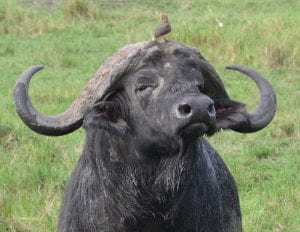


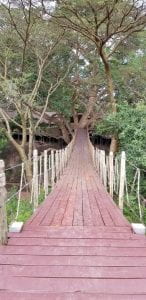


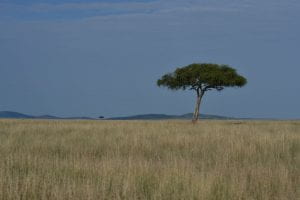




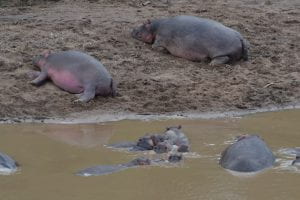


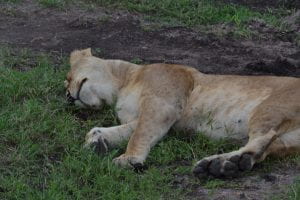
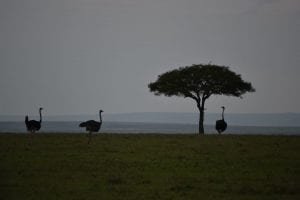

Savanna driving.






















Savanna driving.
On Sunday evening, before the general INMS meeting began, a group from the Kisumu field trip plus several others got together for dinner and a beer. Very interesting and inspiring to be sitting around a table with scientists from five continents: Asia, Africa, Europe, N. America, and S. America. We were only missing the Aussies! Clockwise from left: Felipe Pacheco (Brazil), N. Raghuram (India), Tapan Adhya (India), Cargele Masso (Cameroon), Azusa Oita (Japan), two whom I don’t know, Mark Sutton (INMS Project Lead, UK), one hidden, Xiaoyuan Yan (China), Sergiy Medinets (Ukraine), Oksana Butrym (Ukraine), Kateryna Utkina (Ukraine), Camille Nolasco (Brazil), and Jean Ometto (Brazil).
Our meeting was held at the United Nations headquarters in Nairobi. Maybe I’m a bit of a sap, but I found it inspiring to approach our meeting each day through the walkway bordered by the flags of all the member countries. After passing through really intensive security and showing ID badges, that is.
The front of the UN meeting building. The sign, “karibUNi”, has a nice play on words. “Karibu” is Swahili for “thank you”; then, of course, there’s the blue “UN”, and “UNi” is French for “united”.
We had our plenary sessions in the main meeting room, complete with alphabetical country signs and individual microphones. The first day of the meeting included an overview of the INMS goals and progress for the UN Environment Programme Permanent Representatives from many of the countries. Several of those representatives also spoke, addressing the progress of and challenges facing their respective countries for sustainable nitrogen management. One of the most touching came from the representative from Sri Lanka, who touched on their environmental issues, but also the tragedy of the recent, horrific Easter bombings in that country. The U.S. representative H.E. (Her Excellency) Ms. Lori Dando spoke predominantly about the U.S. commitment to nitrogen management as exemplified by various activities of the U.S. Environmental Protection Agency.

One of the important recent accomplishments by Mark Sutton and INMS was to work with UNEP to pass a resolution addressing sustainable nitrogen management (see resolution L.16) at the Fourth UN Environment Assembly (UNEA-4). Currently, nitrogen issues are addressed in several diverse UNEP programs and policy platforms, including, for example:
But none of these other platforms address N management in a coherent way. The UNEA-4 Nitrogen Management Resolution proposes, not yet another policy platform, but instead an coordinating body to help integrate nitrogen issues across all the existing platforms.
Throughout the rest of the meeting, we provided updates on our various efforts in different components of INMS, and had discussions to coordinate activities between those components.
Work hard and have fun. Mark Sutton and Emily Baker (both at Univ. of Edinburgh) lead a round of Celtic dancing after the meeting dinner on Tues. April 30.
Daniel Ddiba (Stockholm Environment Institute) leads an enthusiastic group (including me) in an African pop dance.
By Wednesday, I needed to escape hotels and meeting rooms, so Jean Ometto and I took an early morning run to the nearby Karura Forest Reserve – right within the city of Nairobi. After running past heavily guarded embassies and the UN compound, we entered a much more natural world – greeted at sunrise by crowned cranes hanging out on the soccer field by one of the Forest entrances.
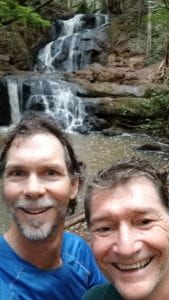 Jean and I by the waterfall in the Forest Reserve.
Jean and I by the waterfall in the Forest Reserve. 
The so-called Mau-Mau caves, in which fighters from Kenya’s quest for independence (the Mau-mau Rebellion) hid during the 1950’s. Now, this is a nesting site for a small population of bats.
 There are still some large native trees in this relatively intact section of riparian forest. Other parts of the Karura Forest Reserve are dominated by forestry plantations (e.g., Eucalyptus species).
There are still some large native trees in this relatively intact section of riparian forest. Other parts of the Karura Forest Reserve are dominated by forestry plantations (e.g., Eucalyptus species).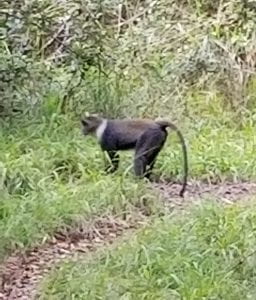 I’m not used to seeing monkeys on my morning runs.
I’m not used to seeing monkeys on my morning runs.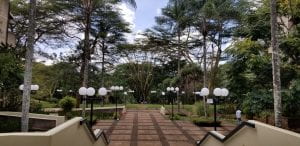
The grounds at the UN complex provided good respite from meeting rooms, and to get a quick walk to stretch my legs after lunch.
More monkeys, here scaling the UN complex walls.
Participants at INMS-4, after conclusion of a successful meeting.
On Day 2 (April 28) of our Lake Victoria Basin field trip in Kisumu, we went down to Hippo Point to view the local invasion of water hyacinth, a noxious invasive plant that clogs waterways worldwide. It loves nutrient-rich waters. Cargele noted that earlier this spring, water hyacinth filled the entire bay between Hippo Point and downtown Kisumu, seen in the distance in the photo below.

The guide for the boat in the foreground was so knowledgeable, that he convinced our group to take an unplanned excursion to see the local hippos.
Safety first! We all got our life jackets and had just enough seats for everyone in the group.
Yes – hippos! The guide noted that this group of hippos is particularly acculturated, and therefore not very aggressive. Evidently, if we’d gotten this close to hippos “in the wild”, they would have charged our boat. Later, on safari in Masai Mara, the guide there noted that wild hippos are one of the most dangerous animals in Africa (along with lions, Cape buffalo, and elephants). Everyone agreed this unplanned excursion was a highlight of our trip.

 So, what happened to all the water hyacinth that had clogged Kisumu Bay? Evidently, changes in winds started blowing it across the Winam Gulf (the arm of Lake Victoria on which Kisumu sits) toward Homa Bay – where we’d driven the day before on our way to Mbita and ICIPE. Here, you can see rafts of water hyacinth adrift on the lake.
So, what happened to all the water hyacinth that had clogged Kisumu Bay? Evidently, changes in winds started blowing it across the Winam Gulf (the arm of Lake Victoria on which Kisumu sits) toward Homa Bay – where we’d driven the day before on our way to Mbita and ICIPE. Here, you can see rafts of water hyacinth adrift on the lake.Next stop on our tour of the anthropogenic water cycle in Kisumu was the Kisumu Sewage Treatment Plant – a rare gem that most tourists to the area never get to see. Caroline Omolo, Safety, Health, Environment and Quality Manager of water treatment for Kisumu, led us through the facilities.
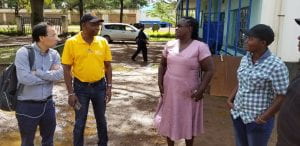




The sewage treatment plant is reasonably successful – effluent has only ~1-3 mg N/L, though they have more difficulty with phosphorus (20-30 mg P/L). Unfortunately, it’s not the treatment plant technology that leads to water quality difficulties. Elizabeth explained that only ~8% of Kisumu residents are hooked up to sewarage, and when treatment plant effluent is released into the adjacent river, it actually makes the river water cleaner. That’s because of large unplanned settlements just upstream that have no water or sewage infrastructure at all. Wastewater just goes directly into the river, and thence into Lake Victoria. Bottom line is that, at least in part, resolving nutrient (and other) pollution in Lake Victoria isn’t primarily a scientific or technological problem, so much as a social, economic, and infrastructure problem: how to get all those people hooked up to clean water and sewage treatment?

Next stop was the water intake for the Kisumu drinking water treatment plant (the green pipes in the photo on the left). Note the extensive screening, in part to keep out all the water hyacinth (photo on right).


After the settling ponds, much of the turbidity is gone and subsequent chlorination makes the water potable. This all looked great to me, but begged the question: why do all the guidebooks emphasize “Don’t drink the tap water anywhere (even the fancy hotels) in Kenya!”? Evidently, the answer is again infrastructure: leaky distribution pipes due to age, construction damage, etc. mean that what leaves the water treatment plant can get contaminated on the way to the tap.
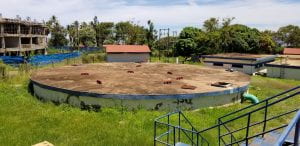

As we flew out of Kisumu back to Nairobi, we got a final glimpse of large mats of water hyacinth drifting across the Winam Gulf toward Homa Bay.
First couple of days in Kenya
It was a long 36 hours of traveling from Bellingham to Kisumu, Kenya, for our pre-meeting field trip to tour the Lake Victoria Basin Regional Demonstration site (at least, the Kenyan portion) of the International Nitrogen Management System (INMS). This is leading up to the INMS Joint Meeting 4 in Nairobi this week. (There’s a surprisingly good overview of the geography, history, and environmental problems at Lake Victoria – the headwaters of the White Nile – on Wikipedia.)
I arrived in Kisumu mid-day on Friday, April 26, and after a nice welcome dinner with guests from the Lake Victoria Basin Commission (LVBC), the tour started Sat. morning. We toured the West Kanu Irrigation Scheme, set up primarily for rice farming, then drove another couple of hours out to see an atmospheric monitoring site at Mbita. On the way, we saw a lot of Kenyan landscape. This, however, is no longer the realm of lions, zebras and giraffes – the Lake Victoria Basin has the highest population densities outside of any major watershed in Africa. Almost every square meter is being used for grazing, agriculture, or living – with subsequent degradation of water quality throughout. Researchers are trying to figure out how to reduce nutrient pollution but still maintain agricultural production to support the population.
I attended IWC-9, focused on “Sustaining International Waters Cooperation”, November 5-8, 2018, in Marrakech, Morocco. I represented our Nooksack-Fraser Transboundary Nitrogen Project (NFTN), one of seven demonstration projects world-wide as part of the International Nitrogen Management System (INMS), which is funded through the Global Environment Facility (GEF). This was very different from the standard scientific meeting. Talks and workshops focused on projects aiming to address environmental problems in both freshwater and marine ecosystems, in a way that is sensitive to local needs and cultures. Just like scientific meetings, though, there were lots of acronyms! Here are some links to info about the meeting:
International Waters: Learning Exchange and Resource Network (IW:LEARN) Facebook page, with conference photos.




Hooper Lab MSc graduate Amanda (Mandie) Carr won the Simberloff Award for Outstanding Student Presentation from the Invasion Ecology Section of the Ecological Society of America at the 2018 Annual Meeting of ESA in New Orleans. Congratulations, Mandie!

We’re excited to see our long-term efforts pay off with publication in Ecology Letters of an Ideas & Perspectives piece: “Ecosystem context illuminates conflicting roles of diversity in ecosystem carbon storage.” Our goal was to help merge the “state factors” approach from ecosystem ecology and the biodiversity & ecosystem functioning perspective. That is, how much new information do we gain if we include diversity as an interactive factor affecting ecosystem properties, in the context of other well-known ecosystem controls, such as climate, topography, time since disturbance, and organism functional traits? We used a long-term, broad-scale data set from Quebec forests to explore this question.
Here’s an artist’s conception of this paper by undergraduate student Rowan Day.